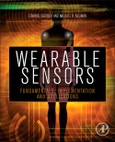Wearable Sensors covers a wide variety of topics associated with the development and application of various wearable sensors. It also provides an overview and coherent summary of many aspects of current wearable sensor technology. Both industry professionals and academic researchers will benefit from this comprehensive reference which contains the most up-to-date information on the advancement of lightweight hardware, energy harvesting, signal processing, and wireless communications and networks. Practical problems with smart fabrics, biomonitoring and health informatics are all addressed, plus end user centric design, ethical and safety issues.
- Provides the first comprehensive resource of all currently used wearable devices in an accessible and structured manner.- Helps engineers manufacture wearable devices with information on current technologies, with a focus on end user needs and recycling requirements.- Combines the expertise of professionals and academics in one practical and applied source.
Table of Contents
1.1. Wearables: Fundamentals, Advancements, and a Roadmap for the Future 1.2. Social Aspects of Wearability and Interaction 1.3. Wearable Haptics
2.1. Wearable Bio and Chemical Sensors 2.2. Wearable Inertial Sensors and Their Applications 2.3. Application of Optical Heart Rate Monitoring 2.4. Measurement of Energy Expenditure by Body-worn Heat-flow Sensors
3.1. Knitted Electronic Textiles 3.2. Woven Electronic Textiles 3.3. Flexible Electronics from Foils to Textiles: Materials, Devices, and Assembly
4.1. Energy Harvesting at the Human Body 4.2. Introduction to RF Energy Harvesting 4.3. Low-Power Integrated Circuit Design for Wearable Biopotential Sensing 5.1. Wearable Algorithms: An Overview of a Truly Multi-Disciplinary Problem 5.2. Mining Techniques for Body Sensor Network Data Repository 5.3. Modeling Physical Activity Behavior Change
6.1. Human Body Communication for a High Data Rate Sensor Network 6.2. Channel Models for On-Body Communications 6.3. Trust Establishment in Wireless Body Area Networks 6.4. Wireless Body Area Networks
7.1. Fundamentals of Wearable Sensors for the Monitoring of Physical and Physiological Changes in Daily Life 7.2. Wearing Sensors Inside and Outside of the Human Body for the Early Detection of Diseases 7.3. Wearable and Non-Invasive Assistive Technologies 7.4. Detection and Characterization of Food Intake by Wearable Sensors








